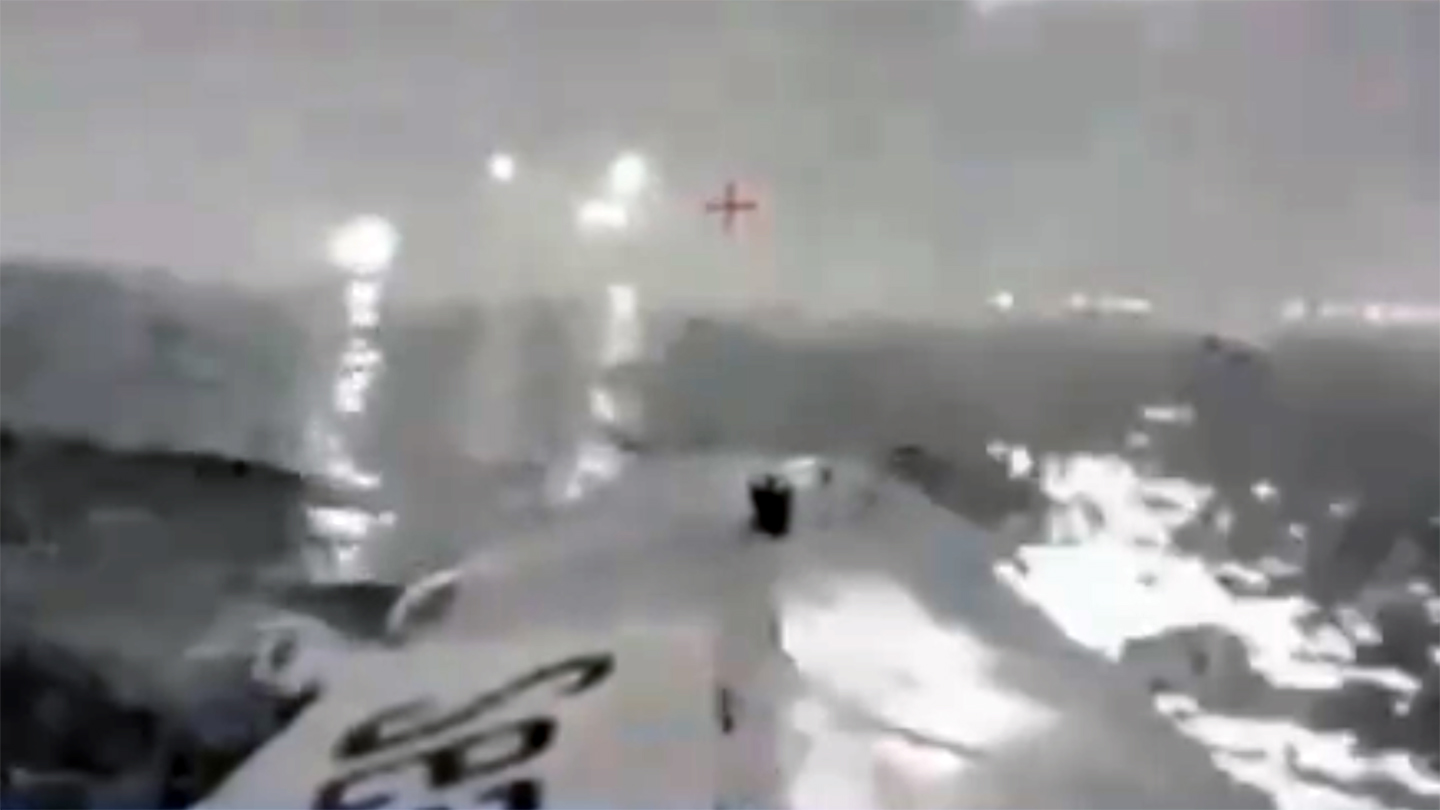Ukraine’s security service (SBU) claims it used a Sea Baby uncrewed surface vessel (USV) armed with rocket launchers for the first time to attack Russian ships near Sevastopol. The Ukrainian Pravda (UP) news outlet on Monday published a video provided by the SBU that it says shows the system’s first use. Still, the practicality of such a concept is questionable, with very limited use cases at best.
The publication, which interviewed SBU head Vasyl Maliuk, reported that the video “shows Ukrainian SBU drones firing at Russian boats that jumped out of one of the Crimean military ports to sink the drones. But the drones, instead of running away, turned around and opened fire in return.”
The 15-second video shows what appears to be 14 munitions fired, presumably from Sea Baby USVs, but it does not show the results of the engagement. The UP story does not explain what happened during this undated battle, whether any damage was inflicted or whether the USVs survived.

The publication said “…there is already a flamethrower system on drones, which allows you to conduct a naval battle in the literal sense.”
The Sea Baby USV depicted in the UP video was likely armed with unguided RPV-16 thermobaric rocket launchers, Andrii Ryzhenko, a retired Ukrainian Navy captain told The War Zone.
Thermobaric weapons use oxygen from the surrounding air to generate a high-temperature explosion and a much more powerful blast wave over a longer duration than a conventional condensed explosive. Images of Sea Baby drones with what appeared to be rocket six rocket launch tubes have been seen before.
Adding this capability is a step beyond using Sea Baby, and other drone boats, for one-way kamikaze attacks.
The Sea Baby USVs were first used in combat last July in an SBU attack on the Kerch Bridge, as we reported previously. Since then, there have been several other Sea Baby attacks, among them one in September on the Russian Project 1239 Bora-class missile corvette Samum and a Russian Project 21630 Buyan class missile corvette and the Project 22160 Vasily Bykov class patrol ship Pavel Derzhavin in separate attacks in October.
These types of USV kamikaze attacks are part of a much wider effort Ukraine began in October 2022 with a massive attack on Sevastopol.
Many other Russian vessels have come under USV attack since, which you can read more about here.
In recent months, though, Ukraine’s “philosophy of using maritime drones has changed” UP reported, citing Ukrainian officials.
“We want to decompose a large warship into its functions – air defense, weapons, protection – and put these weapons on several drones,” an SBU brigadier general with the call sign “Hunter” told the publication. “Ukraine does not have the time or money to build large warships, but a swarm of drones, which will include anti-aircraft drones, kamikaze drones, drones with guns, and so on, can solve the issue of the fleet in a completely different way.”
“Sea Baby is no longer just a naval drone, but a multi-purpose platform that the SBU actively uses today for various tasks, including for attacks on the Black Sea Fleet of the Russian Federation,” Maliuk said, according to UP. “Translated into simpler language, Ukrainian drones have ceased to be ‘kamikaze’ – now most of them return to their bases after missions.”
While this sounds intriguing, just how effective distributing all these capabilities onto relatively tiny unmanned watercraft with very limited autonomy can be is a highly debatable proposition.
Even the utility of merely placing unguided rockets on a USV is questionable. A small boat bobbing around launching unguided rockets is about as far from precise as one can get. The use of thermobaric warheads may help with that by increasing the blast radius above the surface, but the chances they will hit the mark seen very low. Bombarding a coastline could be a different story, though.
“Unguided rockets firing from a shaking platform on the go is just sporadic fire,” a Ukrainian defense official told The War Zone Tuesday. “It has little practical value.”
There is also the question of releasing a barrage like this at very close range to a targeted ship, although if the rockets are launched at a fixed angle for a lofted trajectory, as they appear to be, this may not matter.
One of Maliuk’s stated goals is to prevent Russia from launching attacks on Ukrainian cities from the water.
“We want to knock out all missile carriers from the Ukrainian Black Sea,” he said. “And then we will turn our attention to submarines.”
“President Zelensky set a task: to make sure that Ukraine dominates the Black Sea. For the SBU, this area is one of the priorities,” Maliuk emphasized.
That goal has a long way to go.
The Ukrainian Air Force on Tuesday said Russia fired three 3M14 Kalibr land attack cruise missile (LACMs) as part of a massive missile and drone attack across the country. While the Ukrainian Air Force said all three were shot down, the fact that there are ships still launching them remains a big problem.

Still, the use of USVs as guided munitions has since become a staple of Ukrainian maritime playbook. Regardless of the practicality of adding rockets to them, Ukraine is clearly intent in drastically changing how they use uncrewed boats in the future.
Contact the author: howard@thewarzone.com
